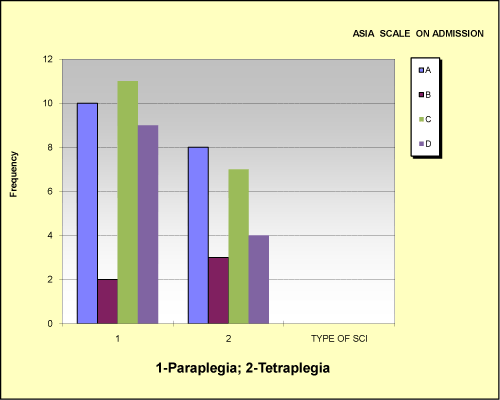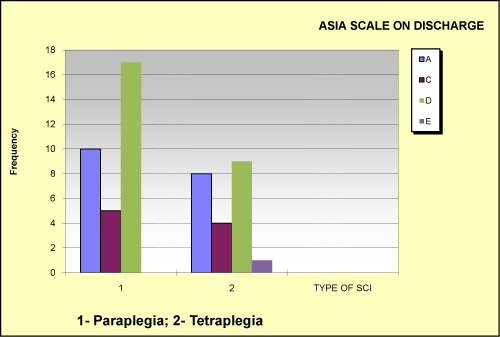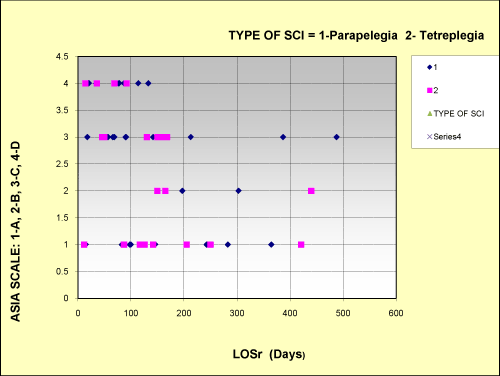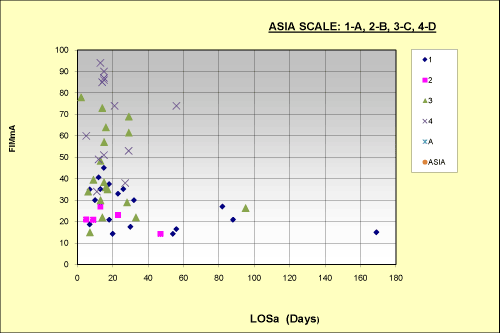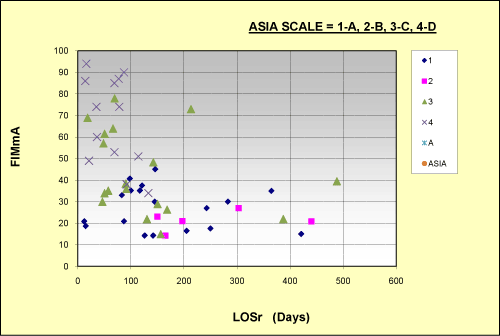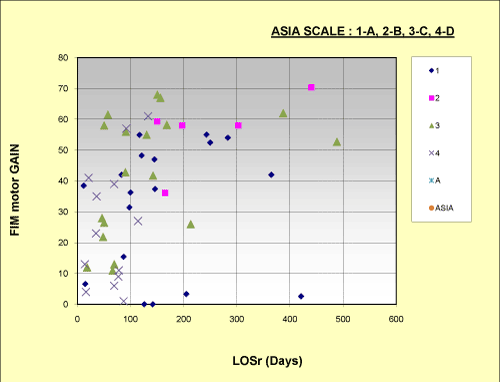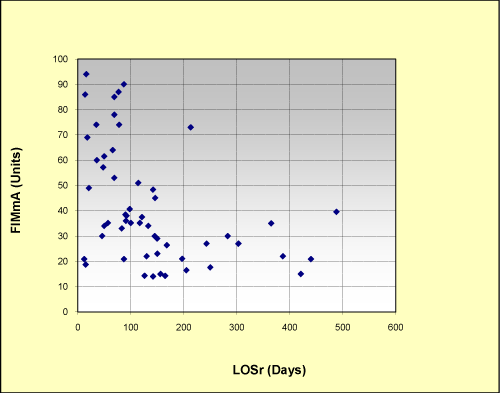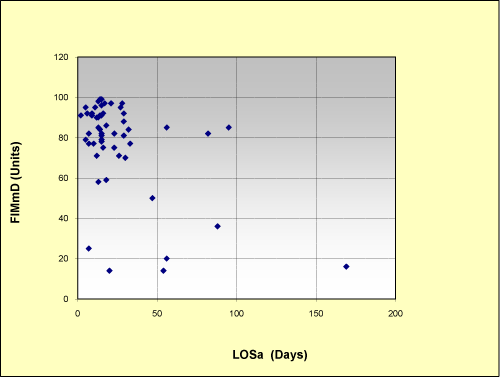| Research Article |
Open Access |
|
| Loganathan Venkatachalam1*, Wafa Al Yazeedi 1, Linsha Anne George2 |
| 1Physical medicine & Rehabilitation Unit, Hamad Medical Corporation, Doha, Qatar |
| 2Rehabilitation Unit, Hamad medical corporation, Doha, Qatar |
| *Corresponding authors: |
Dr. Loganathan Venkatachalam, MD
Specialist, Physical medicine & Rehabilitation
Hamad Medical Corporation, Doha, Qatar
E-mail: vloganathan@hmc.org.qa |
|
| |
| Received March 13, 2012; Published July 16, 2012 |
| |
| Citation: Venkatachalam L, Yazeedi WA, George LA (2012) Predictors of the Length of Stay of Inpatients in Rehabilitation Setting After Traumatic Spinal Cord Injury. 1: 141. doi:10.4172/scientificreports.141 |
| |
| Copyright: © 2012 Venkatachalam L, et al. This is an open-access article distributed under the terms of the Creative Commons Attribution License, which permits unrestricted use, distribution, and reproduction in any medium, provided the original author and source are credited. |
| |
| Introduction |
| |
| Spinal Cord Injury (SCI) caused by either traumatic or non traumatic (T SCI or NT SCI) is a major clinical and social problem and lead to permanent disability. SCI is a devastating condition that requires intensive and specialized clinical rehabilitation. |
| |
| Traumatic SCI occurs often at a young age, and life expectancy of persons with SCI has increased in recent decades, although it is still lower than the life expectancy of the general population [1]. |
| |
| Evidence of the benefits of medical rehabilitation is documented typically by the reduction in disability of persons receiving inpatient rehabilitation and by Length of Stay (LOS). Functional outcome, or gain in functional ability during rehabilitation, reflects the effectiveness of clinical rehabilitation, and LOS is often used as a measure of its efficiency [2]. |
| |
| Patients with low motor Functional Independence Measure (FIMTM) [3] scores on discharge are more dependent and are therefore more likely to be discharged to a long-term care facility [4-6]. |
| |
| Those with high motor FIM scores on discharge are likely to return to community living on discharge, even though there may be a need for modification to the living environment to support independent living [4–6]. |
| |
| Traumatic spinal cord lesion occurs primarily in young adults with more than half being between 16 to 30 years of age. Men account for about 80% of cases [7]. |
| |
| Managed care and improvements in medical and rehabilitative expertise are believed to account for declines in rehabilitation LOS [8]. |
| |
| The Walking Index for Spinal Cord Injury (WISCI) scale will show more incremental change than current scales, and therefore demonstrate criterion validation for use in future clinical trials [9]. |
| |
| The Functional Independence Measure (FIM) is the most widely used valid and reliable measure of the severity of disability and rehabilitation outcome, including SCI [10]. |
| |
| Keeping in view of all the above cited variables for LOS and importance of the topic, this study of LOS in inpatient rehabilitation after SCI in Qatar is conducted, where there was no pioneer study. |
| |
| My study supports the hypothesis of an association between length of stay in rehabilitation, functional independence measure motor, and length of stay in acute care, American spinal cord injury association impairment scale and walking index for spinal cord injury. |
| |
| Review of Literature |
| |
| SCI, a leading cause of disability, necessitates the expenditure of considerable resources for the rehabilitation of these patients. |
| |
| Many clinical studies on predictors of functional outcome after SCI have been published in the world literature, but this present study is a pioneering study of functional outcome and length of stay in rehabilitation unit after SCI, in Qatar. |
| |
| Recent reports showed that recovery of walking after paralysis of lower extremities muscles, particularly following acute spinal cord injury, is one of the primary goals of the patients. In fact, while individuals with complete SCI may rank bladder and bowel control at their first preference for independence in self-care. Independent walking was ranked first by patients, who have the capacity to walk. |
| |
| A recent report showed that recovery of walking function in individuals with incomplete SCI was ranked equal with bowel and bladder recover. Recovery of locomotion, therefore, has become a primary goal of both pharmacological and rehabilitative treatment. In the last decade, pharmacological treatment and rehabilitative approaches have been initiated to enhance locomotion capacity of SCI patients. |
| |
| Basic science advances in regeneration of the central nervous system hold promise of further neurological and functional recovery to be studied in clinical trials. In view of these advances, it has become of increased importance to develop new instruments for the precise measure of walking, such as the Walking Index for Spinal Cord Injury (WISCI), for use in clinical trials [9]. |
| |
| Early rehabilitation management has benefit effect of reducing the complication of disability. Early rehabilitation was effective in hastening and promoting improvement in ADLs. The long average LOS may be typical of the situation in Japan. We think it is possible that the insufficiencies in the system of supporting patients with SCI to get back to normal life in Japan result in delayed discharges [11]. |
| |
| Persons with complete tetraplegia stayed longest in the rehabilitation center (median 360 days), against median 191 days for persons with complete paraplegia. The difference between the group with complete tetraplegia and all other groups was statistically significant. |
| |
| LOS was strongly correlated rS (spearman) (–0.61; p < 0.001) to functional outcome, indicating that patients who stayed longer showed worse outcome. As expected, patients with complete tetraplegia showed poorer outcomes than the other groups, and the best outcome was seen in patients with incomplete paraplegia. |
| |
| Patients with incomplete tetraplegia showed largest within-group differences in outcome. Post hoc analyses showed that, except between the groups with incomplete tetraplegia and with complete paraplegia, all differences in FIM motor scores between the four types of injury were significant [12]. |
| |
| For patients with paraplegia, those with NT-SCI tended to have a much shorter LOS, although the FIM motor score was similar on admission and lower at discharge when compared with T-SCI patients. For patients with tetraplegia, those with NT-SCI again tended to have a much shorter LOS, but in contrast to patients with paraplegia, their FIM motor scores were much higher than T-SCI patients on both admission and discharge [13]. |
| |
| Age-related differences were found with multiple demographic variables. Significant measures were ASIA motor index scores at acute-care admission and at discharge, rehabilitation LOS, inpatient rehabilitation hospitalization charges, total LOS, total hospitalization charges, FIM scores at inpatient rehabilitation admission and discharge, FIM change and FIM efficiency. |
| |
| In conclusion, in patients with paraplegia, age appears to adversely affect functional outcome, rehabilitation LOS, and hospital costs. However, neurologic recovery as defined by the ASIA motor scores does not appear to be related to age [14]. |
| |
| The results also reveal that the pressure ulcers were approximately threefold less when a patient is cared in a SCI trauma center. It emphasizes the time, effort and education in daily monitoring of skin aimed at preventing pressure ulcers starting by waiting on a trolley from the emergency room awaiting investigations and clinical workup, and thus delaying admission to a hospital bed where pressure relieving protocol can begin. |
| |
| Pressure ulcers increase the cost of care, and can delay or prolong rehabilitation due to restrictions in sitting. Acute care readmissions from IRF are dependent mainly on the preadmission medical stability status. |
| |
| Providing a coordinated, multidisciplinary system of acute care and rehabilitation for individuals disabled by SCI allows staff to develop expertise in SCI care, and allows patients to begin initial rehabilitation sooner and in better condition. |
| |
| LOS is frequently viewed as an indicator of the effectiveness of health care delivery. Even though shorter LOS is a result of effective management, expertise and organization of resources, LOS is dependent on multiple factors including level of injury, medical co morbidities, health care practices, insurance, reimbursement pattern, social, psychological, financial and the discharge destination. |
| |
| Nevertheless, the SCI Trauma care’ seems to begin to look into these important rehabilitation aspects right from the day of injury as much as medical and surgical intervention [15]. |
| |
| The ASIA protocol describes a standardized clinical examination of motor and sensory functions in cases of traumatic Spinal cord Lesion (SCL). It has been used for assessment in the cases of ischemic SCL also. ASIA impairment scale was used with traumatic and non-traumatic SCL in this study both at admission and at discharge. |
| |
| While comparing between the groups, it was found that the score were significantly higher in non-traumatic group both at admission and at discharge as compared to traumatic SCL group, thereby meaning that impairment was more in traumatic SCL group at the time of admission for rehabilitation and at discharge. The same trend has been observed in the earlier studies also. Non-traumatic SCL tends to be associated with more incomplete injuries [16]. |
| |
| While there is clear evidence that the average LOS for inpatient rehabilitation after SCI is shorter than in the past, the status of outpatient rehabilitation service delivery has barely been studied. In the United States, LOS has dropped dramatically over the last halfcentury. Information in the National Spinal Cord Injury Database (NSCID) allows a consistent comparison over a 35-year period. |
| |
| For patients admitted to one of the Model Systems immediately after injury (i.e., excluding transfers), the rehabilitation LOS dropped from a median of 98 days during 1973 to 1979, to 37 days during 2005 to 2008. The decline occurred in all SCI impairment groups, although not to the same degree. |
| |
| Managed care and improvements in medical and rehabilitative expertise are believed to account for declines in rehabilitation LOS some worry that the reductions have gone too far. LOS reductions may be associated with more efficient or more intense treatment, or simply less treatment, but one possibility is that outpatient care substitutes for inpatient treatment. |
| |
| Factors influencing the potential substitution of post discharge for inpatient therapies might include a possible cost savings from reducing the service intensity provided in the hospital setting, better meeting the expectations of payers for shorter LOS, and better targeting of therapies to community experienced needs. However, the potential substitution of post discharge for inpatient services also may increase the need for attendant care and the burden on families. |
| |
| Whether the reduction of inpatient SCI rehabilitation LOS may have been accompanied by a change in the amount of post discharge services has been studied sparsely if at all. The SCI literature has little to say about the nature and extent of post discharge rehabilitation services. |
| |
| While there are myriad articles describing specific interventions implemented as part of an outpatient or day rehabilitation program and the outcomes achieved, there is almost nothing published as to the specific rehabilitative services received after discharge from inpatient rehabilitation and for how long. |
| |
| The only study found to report on outpatient therapy hours is that by Kogos et al., who analyzed NSCID information for discharges between 1995 and 1999. While the average LOS in this period was fairly stable (mean, 52d), the percentage of patients who reported receiving any post discharge PT, OT, or both, increased steadily from 24% to 74%. The percentage receiving at least 100 hours of OT and PT combined during the same time rose from 3% to 24%. |
| |
| The authors suggested that these increases were in reaction to LOS decreases in prior years. They did not find associations between the amount of post discharge OT/PT and functional status, community integration, or quality of life at the first anniversary of injury, suggesting that the relationships between LOS need for and receipt of post discharge services, and short-term outcomes are complex [17]. |
| |
| For patients with SCI, a complex interplay of socio demographic and injury related factors can impact on discharge outcomes such as Length of Stay (LOS), functional status and discharge setting following inpatient rehabilitation. |
| |
| Patients with low motor FIM scores on discharge are more dependent and are therefore more likely to be discharged to a longterm care facility. Those with high motor FIM scores on discharge are likely to return to community living on discharge, even though there may be a need for modification to the living environment to support independent living [18]. |
| |
| Ambulation following SCI and conventional therapy can be predicted by the manual muscle test scores of the lower limbs, the completeness of the lesion, and the neurological level of injury. |
| |
| However, new evidence suggests that the degree of voluntary motor control of the lower extremities may not be a predictor of locomotor outcome. This perspective was supported by our observations of subject 2, whose independent stepping ability preceded his ability to voluntarily contract his lower-extremity muscles. |
| |
| In addition, subject 1, who had no detectable voluntary movement below the spinal cord lesion, was able to generate steps independently on the treadmill, although she did not achieve over ground walking. Together, these 2 observations further challenge the validity of predicting locomotor outcomes after an SCI solely based on voluntary motor control [19]. |
| |
| Andrea L Behrman remarked as many individuals with Spinal Cord Injury (SCI) do not regain their ability to walk, even though it is a primary goal of rehabilitation. Mammals with thoracic spinal cord transection can relearn to step with their hind limbs on a treadmill when trained with sensory input associated with stepping. |
| |
| If humans have similar neural mechanisms for locomotion, then providing comparable training may promote locomotor recovery after SCI. We used locomotor training designed to provide sensory information associated with locomotion to improve stepping and walking in adults after SCI. |
| |
| Four adults with SCIs, with a mean post injury time of 6 months, received locomotor training. Based on the American Spinal Injury Association (ASIA) Impairment Scale and neurological classification standards, subject 1 had a T5 injury classified as ASIA A, subject 2 had a T5 injury classified as ASIA C, subject 3 had a C6 injury classified as ASIA D, and subject 4 had a T9 injury classified as ASIA D. |
| |
| All subjects improved their stepping on a treadmill. One subject achieved over ground walking, and 2 subjects improved their over ground walking. Locomotor training using the response of the human spinal cord to sensory information related to locomotion may improve the potential recovery of walking after SCI. |
| |
| Methods |
| |
| A total of 54 patients with traumatic spinal cord injury, discharged from the Inpatient Rehabilitation Unit (IPRU), Rumaillah Hospital of Hamad Medical Corporation, Doha, Qatar, during the period from January 2008 to July 2010, were included in this prospective study. |
| |
| All descriptive data were collected from demographic data files maintained by Medical Records Department, Rumaillah Hospital of the Hamad Medical Corporation. The demographic information on age, sex, marital status, nationality, and type of SCI has been included in the study. The Functional Independence Measure (FIM) was used for measuring the functional status on admission and discharge [9,19]. |
| |
| It analyzed 18 items and seven levels of performance in eating, grooming, bathing, upper and lower body dressing, toileting, bladder and bowel management, bed transfer, toilet transfer, shower transfer, locomotion, stairs, comprehension, expression, social interaction problem solving, and memory. By summing the points for each item, the possible total score ranges from 18 (lowest) to 126 (highest level of independence). |
| |
| It was also expressed in percentage of the functional levels: less than 25%, total assistance; 25–49%, maximal assistance; 50–74%, moderate assistance; 75% or more, minimal contact assistance; then supervision (cuing, coaxing, prompting), modified independence (extra time, devices), and complete independence (timely, safely) [20]. The FIM was administered to every SCI patient within 78 h of admission to the rehabilitation unit and before discharge by the staff occupational therapist, and was reviewed by rehabilitation team conference. |
| |
| A modified disability scale [21] was used on discharge to evaluate disability level. Mobility outcome was recorded based on patient condition on discharge using the modified mobility scale: no walking deficit, slow gait speed (more than 6 sec/10 m), walks with aid, and walks with assistance of other person, self-propel wheelchair, or wheelchair propelled by other. |
| |
| The WISCI is a new 0–20 level scale, which evaluates walking based on physical assistance, the need of braces and devices. The levels are scored from 0 (patient unable to walk) to 20 (patient walking without braces and/or devices and without physical assistance for at least 10m) (Table 1). In scoring, the level in which the patient is safe as judged by the physical therapist was assigned [8,16,22]. |
| |
|
|
Table 1: Walking Index for Spinal Cord Injury (WISCI II). |
|
| |
| Traumatic SCI patients who were admitted to IPRU, Rumaillah hospital were assessed by using of the International Standards for the Neurological Classification of Spinal Cord Injury (ISNCSCI), based on American Spinal Cord Injury (ASIA) and International Medical Society of Paraplegia (IMSOP) classification of ASIA/IMSOP 1992 version (ISCSCI-92) and 2009 review and revisions of ISNCSCI [23,24]. ASIA Impairment Scale classifications A and B were defined as motor complete, C and D as motor incomplete (Table 2). |
| |
|
|
Table 2: ASIA impairment scale. |
|
| |
| Neurological lesion levels below T1 were defined as paraplegia, while lesion levels at or above T1 were defined as tetraplegia. These were clarified as follows: |
| |
| Tetraplegia (preferred to ‘quadriplegia’) |
| |
| This term refers to impairment or loss of motor and/or sensory function in the cervical segments of the spinal cord due to damage of neural elements within the spinal canal. |
| |
| Tetraplegia results in impairment of function in the arms as well as in the trunk, legs and pelvic organs. It does not include brachial plexus lesions or injury to peripheral nerves outside the neural canal. |
| |
| Paraplegia |
| |
| This term refers to impairment or loss of motor and/or sensory function in the thoracic, lumbar or sacral (but not cervical) segments of the spinal cord, secondary to damage of neural elements within the spinal canal. With paraplegia, arm functioning is spared, but, depending on the level of injury, the trunk, legs and pelvic organs may be involved. |
| |
| The term is used in referring to cauda equina and conus medullaris injuries, but not to lumbosacral plexus lesions or injury to peripheral nerves outside the neural canal. |
| |
| Incomplete injury |
| |
| If partial preservation of sensory and/or motor functions is found below the neurological level and includes the lowest sacral segment, the injury is defined as incomplete. Sacral sensation includes sensation at the anal mucocutaneous junction as well as deep anal sensation. |
| |
| The test of motor function is the presence of voluntary contraction of the external anal sphincter upon digital examination. |
| |
| Complete injury |
| |
| This term is used when there is an absence of sensory and motor function in the lowest sacral segment [23-25]. |
| |
| Variables |
| |
| The dependent variable was Length of Stay in rehabilitation (LOSr) and the independent variables were age, FIM Cognitive score on admission and discharge (FIMca), (FIMcd), motor FIM score on admission (FIMma) and discharge (FIMmd), length of stay in acute care (LOSa), WISCI, ASIA impairment scale on admission and discharge (ASIAa, ASIAd) modified disability scale, and modified mobility scale. |
| |
| Statistical methods |
| |
| Descriptive analysis was done for continuous as well as categorical variables. Pearson correlation coefficient was used to see association between the continuous variables. Student t test and one-way. ANOVA with post hoc Boneferroni analysis were performed to see mean level differences between and among categories of different variables, respectively. Regression analysis was performed to see predictor variables for dependent variable (LOSr). |
| |
| A p value of 0.05 was considered to be a statistically significant level. SPSS 14.0 statistical package was used for analysis. |
| |
| Results |
| |
| The study included 54 SCI patients with an age range of 20-60 years. The distribution of qualitative characteristics is shown in Table 3. Most of the patients (98%) were expatriates, and the type of lesion was paraplegia in 59% and tetraplgia in 41%. |
| |
|
|
Table 3: Distribution of qualitative characteristics in the sample (54). |
|
| |
| The majority of SCI patients on discharge were in the disability range of disabled but independence in self-care (32%), followed by minor symptoms not affecting life style (24%) and moderate assistance for daily living (22%). The rest were in two other groups of disability (14%), with up to maximal assistance, total assistance (4%) and well (4%) in daily living. |
| |
| Regarding the mobility category, most of the patients were in wheelchair propelled by themselves (37%), group of walks with aid (22%), and in the group of slow gait speed (19%). The others were in wheelchair propelled by others (9%) and walks with another person to help (2%). |
| |
| |
| No walking deficit was in only 11% of the SCI patients. This study showed SCI patients admitted in IPRU were in complete paraplegia (ASIA A) group as 56% [10] and complete tetraplegia 44% [8]. |
| |
| Sensory incomplete paraplegia and tetraplegia (ASIA B) as 40% [2] and 60% [3]. Motor incomplete (ASIA C and ASIA D) paraplegia and tetraplegia were 61% [11], 39% [7] and 69% [9], 31% [4], respectively. |
| |
| On discharge the complete paraplegia and tetraplegia (ASIA A) were 56% [10] and 44% [8]. Motor incomplete paraplegia (ASIA C and D) were 56%, 65% [5,17] and tetraplegia as 49%, 35% [4,9]. This showed the complete paraplegia has no functional motor improvement whereas incomplete sensory group has improved in functional motor. There was only one SCI patient reached normal functional level (ASIA E) (Table 4, Figure 1 and 2). |
| |
|
|
Table 4: ASIA Scale and type of SCI. |
|
| |
|
|
Figure 1: ASIA Scales on admission. |
|
| |
|
|
Figure 2: ASIA Scales on discharge. |
|
| |
| The average LOSr of complete paraplegia, tetraplegia and incomplete paraplegia and tetraplegia were 160, 170, 122 and 127 days respectively (Table 5). |
| |
|
|
Table 5: Averages on LOSr. |
|
| |
| The mean levels of age, FIMcA ,FIMcD, FIMmA FIMmD, Gain, WISCIa, WISCId, LOSa, and LOSr were 40 years, 95, 99, 42, 78, 36, 4, 10, 25, 169 days and 488 days, respectively (Table 6). |
| |
|
|
Table 6: Descriptive statistics of included variables in this study. |
|
| |
| In 54 patients studied, age is negatively correlated with FIMmA, FIMmD, WISCIa and WISCId and positively correlated to FIMcA, FIMcD, LOSa and LOSr, but statistically not significant (Table 7). |
| |
|
|
Table 7: Correlation of age with length of stay and other variables. |
|
| |
| FIMmA was strongly correlated with WISCIa (r = 0.747, p = 0.00) and FIMmD was correlated with WISCI d(r = 0.621, p = 0.00) (Table 8 and 9). |
| |
|
|
Table 8: Correlation of FIMmA with WISCIa and WISCId. |
|
| |
|
|
Table 9: Correlation of FIMmD with WISCIa and WISCId. |
|
| |
| LOSr was significant negatively correlated to WISCId and FIMmA (r = -0.244, p = 0.000; r = -0.439, p = 0.001) but not significant with WISCIa and FIMmD (r = 0.300, p = 0.028; r = -0.109, p = 0.437) respectively (Table 10 and 11). |
| |
|
|
Table 10: Correlation of LOSr with WISCIa and WISCId. |
|
| |
|
|
Table 11: Correlation of LOSr with FIMmA and FIMmD. |
|
| |
| FIMmD was significant correlated with FIMmA and negative correlation with LOSa (r = 0.551, p = 0.001; r = -0.492, p = 0.001) (Table 12 and 13). |
| |
|
|
Table 12: Correlation between LOSa and FIMmD. |
|
| |
|
|
Table 13: Correlation of ASIAa with LOSr and other variables. |
|
| |
| In this study, regarding ASIA impairment scale on admission was negatively correlated with LOSr and FIMmD but only significant with LOSr (Table 14). |
| |
|
|
Table 14: Correlation of Type of SCI with LOSr and other variables. |
|
| |
| The type of SCI (paraplegia or Tetraplegia) was correlated with LOSr, WISCIa and WISCId and had negative correlation with FIMmA and FIMmD, but significant with FIMmA (Table 15). |
| |
|
|
Table 15: Correlation between FIMmA and Gain. |
|
| |
| There was a negative significant correlation between FIMmA and Gain. |
| |
| Discussion |
| |
| Qatar is a small country with an area of 11,427 km2, extending into the Persian Gulf from the eastern Arabian Peninsula. The entire country is served by the Hamad Medical Corporation. |
| |
| All patients with SCI episodes in Qatar are admitted to the Hamad General Hospital for acute care management and are then transferred, after becoming medically stable, to the Rehabilitation unit in Rumailah Hospital for subacute care and rehabilitation management. SCI, a leading cause of disability, necessitates the expenditure of considerable resources for the rehabilitation of these patients. |
| |
| Many clinical studies on predictors of functional outcome after SCI have been published in the world literature, but this present study is a pioneering study of length of stay and functional outcome after SCI, in Qatar. Rehabilitation outcome was defined as functional abilities at rehabilitation discharge and at follow-up (typically 3 or 12 months). |
| |
| Medical literatures revealed that rehabilitation interventions have a variable relationship with functional outcome after SCI. The prediction of inpatient rehabilitation outcome is relevant for rehabilitation specialists to maximize their client’s preparation for a return home. |
| |
| Post et al. cited age was found to be a significant predictor of LOS in several studies and that age was not relevant in their study might again be explained by the exclusion of people over age 65. |
| |
| In our study, it was found that age was not significantly correlated with all variables particularly with LOSr and FIMmA and FIMmD (Table 7) [12,15,26]. PW New and his associates pointed that LOS and FIM motor subscale scores are further compared between the SCI groups by the level of injury. For patients with paraplegia, those with NT-SCI tended to have a much shorter LOS, although the FIM motor score was similar on admission and lower at discharge when compared with T-SCI patients. For patients with tetraplegia, those with NT-SCI again tended to have a much shorter LOS, but in contrast to patients with paraplegia, their FIM motor scores were much higher than T-SCI patients on both admission and discharge [13]. |
| |
| In our study there we also found that incomplete paraplegia and tetraplegia had shorter LOSr than complete paraplegia and tetraplegia but some patients of incomplete paraplegia had longer LOS (Figure 3). |
| |
|
|
Figure 3: Correlation of ASIA Scale on admission and LOSr of Type of SCI. |
|
| |
| Sumida M et al. [10] remarked ASIA impairment scale score improved in the early rehabilitation subgroup. The percentage of patients exhibiting progression in this subgroup was compatible with the report of the progression by using the Frankel scale. |
| |
| In our study we found FIMmA is significantly correlated with WISCIa and WISICd and FIMmD with WISCId (Figure 8 and 9), that explained WISCI score improved according to the improvement level of FIM. Some studies pointed that ASIA impairment admission had strong correlation with WISCI [8]; where as our study observed no correlation of ASIAa with WISCIa and WISCId (Table 14). |
| |
| We thought that this no correlation is due to the small population study. SCI research studies mentioned that FIM is more important predictor of LOS, a higher FIM related to shorter LOS [11]. |
| |
| Gupta A and associates observed in their study that despite more impairment in persons with traumatic spinal cord lesion, there was statistically no significant difference in the length of stay and the functional outcome between persons with traumatic and nontraumatic spinal cord lesion after in-patient rehabilitation [15]. |
| |
| Our study on ASIA impairment scales were also not correlated with variables of LOSr, FIMmA and FIMmD [14], but we observed that there was functional improvement in ASIA impairment group in acute care (Figure 4). |
| |
|
|
Figure 4: Correlation of LOSa and FIMmA with ASIA Scale. |
|
| |
|
|
Figure 5: Correlation of FIMmA and LOSr with ASIA Scale. |
|
| |
| Lam T and associates cited the WISCI-II, which was also developed specifically for the SCI population, is solely used for the assessment of ambulatory function rather than over ground locomotion in general (i.e. where both wheelchair-use and walking are options). |
| |
| It therefore provides a more comprehensive consideration of the use of braces and assistive devices to achieve overground ambulation not found in the other categorical measures. However, the WISCI exhibits ceiling effects, which could limit its use in assessing individuals with only minor impairments. |
| |
| The WISCI also does not consider gait speed or energy consumption and does not provide any indication of endurance since the distance covered is only 10 meters. It has been suggested that the WISCI would benefit from additional information on walking speed to improve responsiveness and to decrease its ceiling effect [16]. |
| |
| One study indicated that the increase in mean total FIM scores (68.7–102.2) and mean motor FIM scores (35.3–67.3) for the patients from admission to discharge is consistent with the gains documented in other studies. |
| |
| Ditunno et al. [27] reported that people with traumatic SCI generally have a mean total FIM score of 59.5 on admission and 95.3 on discharge (mean gain of 35.9), and a mean motor FIM score of 28.6 on admission and 62.1 on discharge (mean gain of 33.5) . |
| |
| Data from the United Data System for Medical Rehabilitation (UDSMR) for SCI admissions during 1995–1997, with corresponding sample sizes of 3444, 4337 and 4652 cases, showed lower discharge FIM total scores (means of 89.8 to 88.8 over the 3 years, respectively) and lower FIM gains (mean of 26 for 1997) than patients showed in the present study. |
| |
| The total and motor FIM gains for patients in his study were 33.2 and 32.0 points, respectively, indicating that almost all of the gain occurred in the motor component. |
| |
| The results of this study confirm that patients with traumatic SCI generally present with high cognitive FIM scores on admission and discharge. The FIM has been previously shown to be relatively insensitive to changes that may occur in cognitive function in this group of patients. |
| |
| The above mentioned studies supported our result of mean FIM gain (35.85 ± 21.46) (Figure 6), negative statistically significant correlation of LOS with FIMmA (r = -0.439, p=0.001) and higher FIM had Low LOSr (Figure 7). And also LOS in acute care is significant negatively correlated with FIMmD (Table 12) (Figure 8). |
| |
|
|
Figure 6: Correlation of LOSr and FIMm Gain with ASIA Scale. |
|
| |
|
|
Figure 7: Correlation between FIMmA and LOSr. |
|
| |
|
|
Figure 8: Correlation between LOSa and FIMmD. |
|
| |
| Ploumis et al. [14] cited that LOS is frequently viewed as an indicator of the effectiveness of health care delivery. Even though shorter LOS is a result of effective management, expertise and organization of resources, LOS is dependent on multiple factors including level of injury, medical co morbidities, health care practices, insurance, reimbursement pattern, social, psychological, financial and the discharge destination. Nevertheless, the SCI TC seems to begin to look into these important rehabilitation aspects right from the day of injury as much as medical and surgical interventions. |
| |
| Limitations to our study include the differences between SCI patients included in the two groups with regard to sex and type of injury, implying a possible referral to SCI TC of a certain patient population. |
| |
| Also, understanding the limitations of the data, Inpatient Rehabilitation Facility (IRF) LOS is expressed as total number of days hospitalized (days in IRF plus interim days in acute care hospitals) after initial IRF admission. Subgroup analysis was conducted only for acute care LOS, as our primary hypothesis was regarding the quality of acute care. |
| |
| Post et al. remarked in his study that theoretically, discharge should occur when a patient’s functional and educational gains begin to plateau. Research has shown that in the United States, LOS has become too short, the reduction from 74 to 60 days between 1990 and 1998 being accompanied with an increase in hospital readmissions and discharge to nursing homes instead of discharge to the community. |
| |
| According to Ronen et al., a prolonged stay in a specialized center may be positively associated with an improved rehabilitation outcome measured by the Spinal Cord Independence Measure. |
| |
| Elsewhere, we reported improvement of wheelchair skills after the first 3 months of functional rehabilitation, a period that is longer than the mean total period of inpatient rehabilitation in several countries. |
| |
| However, discharge also may be delayed because people have to wait for completion of domestic adaptations or delivery of assistive devices. In an earlier study, we found that one-third of all persons with SCI said that their discharge from the rehabilitation center had been unnecessarily delayed, with a median duration of 15.5 weeks because they had to wait for another house or for adaptation of their current house. |
| |
| This kind of inefficiency should be corrected as soon as possible, because a long stay in an institution not only results in higher costs of rehabilitation but may also result in hospitalization and hamper social reintegration. |
| |
| In Qatar all SCI patients are repatriates of multilingual and different culture. LOS in rehabilitation unit is longer because of more influencing socio economical problems on discharge plan. This leads very hard to discharge the SCI patients within the standard period (90 days) particularly for complete paraplegic and tetraplegic patients. |
| |
| The above mentioned studies triumph the truth of quality of life improvement by shortening the LOS and functional improvement. |
| |
| In Qatar, most of the SCI patients were expatriates (98%) living alone. Patients living alone stayed in the hospital significantly more often than those who had families. It seems that family involvement is an important predictor of disposition of the SCI patient. |
| |
| Early involvement of social services, in provision of environmental aids and adaptations or placement in residential care, would probably reduce the unnecessary hospitalization. From our study, we understand that some barriers are affecting prompt discharge and they should be explored to distinguish between patient’s readiness and any restrictions from administrative and social units. |
| |
| These could help to explain a larger percentage of variance in the intermediate and rehabilitation LOS. |
| |
| Conclusion |
| |
| In relation to other findings, overall, our study showed that FIM admission was the best predictor of functional outcome in SCI inpatients, and also SCI patients of lower admission and discharge FIMs were related to extended LOS in both acute and IPRU. |
| |
| However, we found that some higher FIMd and ASIA impairment group C were also with extended LOSr (Figure 6 and 7), but only 14% of the total SCI patients. The reason for this extended LOSr might be dependent upon socioeconomic factors. |
| |
| Our study identified the need for further prospective studies in large SCI populations in order to evaluate other predictors influencing LOS in rehabilitation units. |
| |
| Acknowledgements |
| |
| We are very thankful and grateful to Dr. Raj Singh, Cardiac Research center, who helped in statistical analysis. I am thankful to Case manger, occupational therapists, physiotherapists, and nurses of the rehabilitation unit for their dedicated contribution to the rehabilitation process. |
| |
| |
| References |
| |
- DeVivo MJ, Krause JS, Lammertse DP (1999) Recent trends in mortality and causes of death among persons with spinal cord injury. Arch Phys Med Rehabil 80: 1411–1419.
- Hamilton BB, Laughlin JA, Fiedler RC, Granger CV (1994) Interrater reliability of the 7-level Functional Independence Measure (FIM). Scand J Rehabil Med 26: 115–119.
- Dijkers MP, Buda Abela M, Gans BM, Gordon WA (1995) The aftermath of spinal cord injury. In: Stover SL, DeLisa JA, Whiteneck GG (eds). Spinal Cord Injury: Clinical Outcomes from the Model Systems. Aspen: Gaithersburg, MD, 185–212.
- Dodds TA, Martin DP, Stolov WC, Deyo RA (1993) A validation of the functional independence measurement and its performance among rehabilitation inpatients. Arch Phys Med Rehabil 74: 531–536.
- DeVivo MJ, Rutt RD, Black KJ, Go BK, Stover SL (1992) Trends in spinal cord injury demographics and treatment outcomes between 1973 and 1986. Arch Phys Med Rehabil 73: 424–430.
- Go BK, DeVivo MJ, Rechards JS (1995) The epidemiology of spinal cord lesion. In: Stover SL, Delisa JA, Whiteneck GG (eds). Spinal Cord Lesion. Aspen: Gaithersburg, MD, 21–25.
- Whiteneck GG, Gassaway J, Dijkers MP, Lammertse DP, Hammond F, et al. (2011) Inpatient and postdischarge rehabilitation services provided in the first year after spinal cord injury: findings from the SCIRehab Study. Arch Phys Med Rehabil 92: 361-368.
- Morganti B, Scivoletto G, Ditunno P, Ditunno JF, Molinari M (2005) Walking index for spinal cord injury (WISCI): criterion validation. Spinal Cord 43: 27-33.
- Guide for the Uniform Data Set for Medical Rehabilitation (Including the FIMTM instrument) (1997) Version 5.1, State University of New York at Buffalo: Buffalo, NY, USA.
- Sumida M, Fujimoto M, Tokuhiro A, Tominaga T, Magara A, et al. (2001) Early rehabilitation effect for traumatic spinal cord injury. Arch Phys Med Rehabil 82: 391-395.
- Post MW, Dallmeijer AJ, Angenot EL, van Asbeck FW, van der Woude LH (2005) Duration and functional outcome of spinal cord injury rehabilitation in the Netherlands. J Rehabil Res Dev 42: 75-85.
- New PW, Simmonds F, Stevermuer T (2011) A population-based study comparing traumatic spinal cord injury and non-traumatic spinal cord injury using a national rehabilitation database. Spinal Cord 49: 397-403.
- Cifu DX, Huang ME, Kolakowsky-Hayner SA, Seel RT (1999) Age, outcome, and rehabilitation costs after paraplegia caused by traumatic injury of the thoracic spinal cord, conus medullaris, and cauda equina. J Neurotrauma 16: 805-815.
- Ploumis A, Kolli S, Patrick M, Owens M, Beris A, et al. (2011) Length of stay and medical stability for spinal cord-injured patients on admission to an inpatient rehabilitation hospital: a comparison between a model SCI trauma center and non-SCI trauma center. Spinal Cord 49: 411-415.
- Gupta A, Taly AB, Srivastava A, Vishal S, Murali T (2008) Traumatic vs non-traumatic spinal cord lesions: comparison of neurological and functional outcome after in-patient rehabilitation. Spinal Cord 46: 482-487.
- Lam T, Noonan VK, Eng JJ; SCIRE Research Team (2008) A systematic review of functional ambulation outcome measures in spinal cord injury. Spinal Cord 46: 246-254.
- Whiteneck GG, Gassaway J, Dijkers MP, Lammertse DP, Hammond F, et al. (2011) Inpatient and postdischarge rehabilitation services provided in the first year after spinal cord injury: findings from the SCIRehab Study. Arch Phys Med Rehabil 92: 361-368.
- Behrman AL, Harkema SJ (2000) Locomotor training after human spinal cord injury: a series of case studies. Phys Ther 80: 688-700
- Fiedler RC, Granger CV, Post LA (2000) The Uniform Data System for Medical Rehabilitation: report of first admissions for 1998. Am J Phys Med Rehabil 79: 87-92.
- JHH Function Acute Care Score (JHH-FACS) Guide Book, John’s Hopkins Hospital.
- Scottish Intercollegiate Guidelines Network (2003).
- Ditunno JF Jr, Ditunno PL, Graziani V, Scivoletto G, Bernardi M, et al. (2000) Walking index for spinal cord injury (WISCI): an international multicenter validity and reliability study. Spinal Cord 38: 234–243.
- Ditunno JF Jr, Young W, Donovan WH, Creasey G (1994) The international standards booklet for neurological and functional classification of spinal cord injury. American Spinal Injury Association. Paraplegia 32: 70-80.
- Waring WP 3rd, Biering-Sorensen F, Burns S, Donovan W, Graves D, et al. (2010) _2009 review and revisions of the international standards for the neurological classification of spinal cord injury. J Spinal Cord Med 33: 346-352.
- Maynard FM Jr, Bracken MB, Creasey G, Ditunno JF Jr, Donovan WH, et al. (1997) International Standards for Neurological and Functional Classification of Spinal Cord Injury. American Spinal injury Association. Spinal Cord 35: 266–274.
- Tooth L, McKenna K, Geraghty T (2003) Rehabilitation outcomes in traumatic spinal cord injury in Australia: functional status, length of stay and discharge setting. Spinal Cord 41: 220-230.
- Ditunno JF, Cohen ME (1995) Functional outcomes. In: Stover SL, DeLisa JA, Whiteneck GG (eds). Spinal Cord Injury: Clinical Outcomes from the Model Systems. Aspen: Gaithersburg, MD, 170–184.
|
| |
| |

